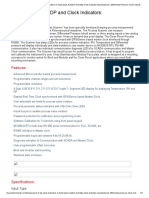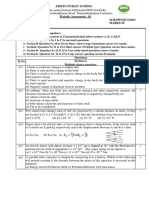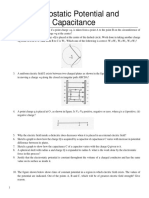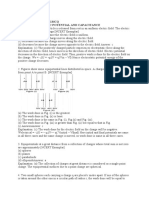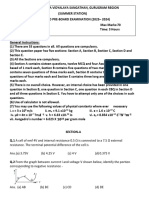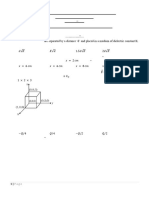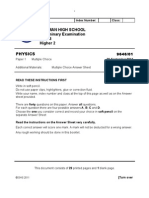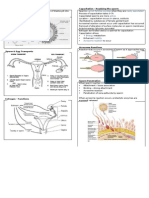1121 Finals 106 New
1121 Finals 106 New
Uploaded by
Prabaharan GunarajahCopyright:
Available Formats
1121 Finals 106 New
1121 Finals 106 New
Uploaded by
Prabaharan GunarajahOriginal Description:
Copyright
Available Formats
Share this document
Did you find this document useful?
Is this content inappropriate?
Copyright:
Available Formats
1121 Finals 106 New
1121 Finals 106 New
Uploaded by
Prabaharan GunarajahCopyright:
Available Formats
5
TEST 2
This test is on the final sections of this session's syllabus and should be attempted by all students.
Anything written here will not be marked.
QUESTION 1
[Marks 10] y
(a) (b) (c)
Explain what is meant by the term a neutral atom? What is meant by the term negatively charged atom?
2a
Three point charges, q, 3q and q are distributed as shown in the diagram. What is the force on the 3q charge?
+q a a -q
+3q
QUESTION 2
[Marks 6]
(a) (b)
If more electric field lines leave a Gaussian surface than enter it, what can you conclude about the net charge enclosed by that surface? Explain. (i) A point charge q is located at the centre of a uniform ring having linear charge density and radius a, as shown in the diagram. Determine the total electric flux through a sphere centred on the point charge and having radius R, where R < a?
+q a
(ii)
Now determine the flux through a sphere with radius R = 2a surrounding the same charge distribution?
QUESTION 3
[Marks 9]
(a)
A negative charge moves in the direction of a uniform electric field. Does the potential energy of the charge-field system increase or decrease? Does the charge move to a position of higher or lower potential? Explain both answers you give. A rod of length L lies along the x-axis with its left end at the origin. It has a non-uniform linear charge density = x, where is a positive constant. What are the units of ? Calculate the electric potential at a point which is at x = _D. You may like to make use of the xdx x a integral # = " 2 ln( a + bx ) . a + bx b b
(b)
QUESTION 4 (a)
[Marks 10]
The plates of a capacitor are connected to a battery. What happens to the charge on the plates if the connecting wires are removed from the battery? What happens to the charge if the wires are then connected to each other? Write one or two clear sentences. Two identical parallel plate capacitors, each with charge C, are charged to potential difference V, disconnected from the battery and connected in parallel. While they are still connected, the separation of the plates for one of the capacitors is doubled. (i) (ii) Find the total energy of the system of two capacitors before the plate separation is doubled. Find the potential difference across each capacitor after the plate separation is doubled.
(b)
(iii) Find the total energy of the system after the plate separation is doubled. (iv) Reconcile the difference in the answers to parts (i) and (iii) with the conservation of energy.
QUESTION 5
[Marks 11]
(a)
A proton is moving in a direction which is up this page. It then enters a region where there is a magnetic field directed out of the page. Explain what happens to the proton. What would have happened if the particle had been an electron, travelling at the same speed? The cube shown in the figure has sides of length r = 40.0 cm. Four straight segments of wire ab, bc, cd and da form a closed loop that caries a current I = 5.00 A, in the direction shown. A uniform magnetic field of magnitude B = 0.020 T in the y-direction passes through the cube. Determine the magnitude and direction of the magnetic force on (i) segment ab, (ii) segment bc, (iii) segment cd and (iv) segment da.
y
(b)
B
~
b z c
QUESTION 6
[Marks 6]
The figure shows a cross-sectional view of a coaxial cable. The centre conductor is surrounded by a non-conducting plastic layer. This is surrounded by an outer conductor, and this is surrounded by another non-conducting plastic layer. The current through the inner conductor is 1.00 A out of the page and the current through the outer conductor is 3.00 A into the page.
plastic a
1mm 1mm 1mm
conductor
Determine the magnitude and direction of the magnetic field at points a and b, which are 1 mm and 3 mm, respectively from the centre of the cable, along the positive x-axis.
QUESTION 7 (a) (b)
[Marks 8]
a R b
State, in words, Faradays Law of Induction. A wire of mass 0.5 kg in the shape of a rectangle of width a = 1 m and length b = 6 m has resistance R = 2 . The wire falls through a magnetic field directed perpendicular to it, as shown. It accelerates until it reaches a constant speed v = 8 m/s. Determine the value of the magnetic induction, B.
You might also like
- MSDS of FlexitankDocument2 pagesMSDS of FlexitankJefe SostenibilidadNo ratings yet
- Temperature RH DPDocument4 pagesTemperature RH DPSupport, SP Tech SolutionsNo ratings yet
- Geese Commercial FarmingDocument24 pagesGeese Commercial FarmingALTAF HUSAIN100% (2)
- Term 1 Adis Wathba 2021 3Document12 pagesTerm 1 Adis Wathba 2021 39295No ratings yet
- Physics 2 MidtestDocument7 pagesPhysics 2 Midtestibrahimalhabsi118No ratings yet
- Cbse-centum-board Model Physics Wt-1 05-10-2024Document4 pagesCbse-centum-board Model Physics Wt-1 05-10-2024dannyeye1515No ratings yet
- PB - II Physics Xii 2023-24Document7 pagesPB - II Physics Xii 2023-24hari008091No ratings yet
- XII PhysicsDocument4 pagesXII Physicsmadankshatriya800% (1)
- Time: 1 Hour Max. Marks: 30: All Questions Carry Equal Marks. There Is No Negative MarkingDocument8 pagesTime: 1 Hour Max. Marks: 30: All Questions Carry Equal Marks. There Is No Negative MarkingSarvan SankaranNo ratings yet
- ElectrostaticsDocument28 pagesElectrostaticssonaliswain2345No ratings yet
- term1 tsta-with solutionsDocument12 pagesterm1 tsta-with solutionsbrainwave.2k24No ratings yet
- Cbse-centum-board Qp Physics Wt-2 19-10-2024Document5 pagesCbse-centum-board Qp Physics Wt-2 19-10-2024mohannirmala2007No ratings yet
- STD Xii - Physics Set A - Cbse Quarterly 22-23Document9 pagesSTD Xii - Physics Set A - Cbse Quarterly 22-23Rizwana RNo ratings yet
- Physics Qp - Set 2Document11 pagesPhysics Qp - Set 2PIO DASNo ratings yet
- Final 2018Document3 pagesFinal 2018Ashraf WaleedNo ratings yet
- Wa0001.Document5 pagesWa0001.The Unknown ShimmerNo ratings yet
- II Pu Phy Mid Term Exam Mqp-3 24-25 KVV SPC (F)Document4 pagesII Pu Phy Mid Term Exam Mqp-3 24-25 KVV SPC (F)shilpa146007No ratings yet
- Electric Charges and FieldsDocument6 pagesElectric Charges and Fieldsdataphysics22No ratings yet
- WS Electrostatic Potential and CapacitanceDocument5 pagesWS Electrostatic Potential and CapacitanceAbanti.DNo ratings yet
- Xii Physics - Chapter 2term 1Document17 pagesXii Physics - Chapter 2term 1RahulNo ratings yet
- CH 1 Electric Charges and FieldsDocument5 pagesCH 1 Electric Charges and Fieldskrekhanandu24No ratings yet
- Physics TestDocument8 pagesPhysics TestrajatiitdNo ratings yet
- 02 - Potential & Cap - AssignmentDocument3 pages02 - Potential & Cap - AssignmentcaceyNo ratings yet
- Exam1 Phys 193 Fall 2014-m2Document12 pagesExam1 Phys 193 Fall 2014-m2alkingkingNo ratings yet
- Dc12phy LN 1Document12 pagesDc12phy LN 1Brilliant online studiesNo ratings yet
- HSSC-II PHYSICS HALF SYLLABUS (16-To-20) April 2021Document4 pagesHSSC-II PHYSICS HALF SYLLABUS (16-To-20) April 2021Heaven ColoursNo ratings yet
- Class XiiDocument3 pagesClass XiiindonesiatmkbNo ratings yet
- Rakhi Mishra 1 149457Document10 pagesRakhi Mishra 1 149457bharathsnair795No ratings yet
- Physics Class Xii Sample Paper Test 05 For Board Exam 2023 AnswersDocument17 pagesPhysics Class Xii Sample Paper Test 05 For Board Exam 2023 AnswersprismtonicNo ratings yet
- Capacitors ProblemsDocument11 pagesCapacitors ProblemsUjjwal JhaNo ratings yet
- revision chapter 1Document2 pagesrevision chapter 1abhinavsharma7thegrtNo ratings yet
- PHYF125 Tutorial Questions Tri 2 201617Document11 pagesPHYF125 Tutorial Questions Tri 2 201617Sufian PianNo ratings yet
- W2016 PHYS259 Final Booklet I AnswersDocument12 pagesW2016 PHYS259 Final Booklet I AnswersYasmeenNo ratings yet
- Aissce Asngmt CH - 01Document5 pagesAissce Asngmt CH - 016pqq745bq2No ratings yet
- PYQs phy class 12Document56 pagesPYQs phy class 12manishnahire911284No ratings yet
- QP_(PHYSICS)_(XII)_Set(No 1)Document8 pagesQP_(PHYSICS)_(XII)_Set(No 1)Sunu DbbarmaNo ratings yet
- p240w12 Mid1-2Document14 pagesp240w12 Mid1-2shlaeaNo ratings yet
- Xii Physics June Set 2Document4 pagesXii Physics June Set 2shreyasinghchampNo ratings yet
- CH1&2Document20 pagesCH1&2nahakslokNo ratings yet
- XII PHY MCQ'S-finalDocument6 pagesXII PHY MCQ'S-finalumarsadiqkhan99No ratings yet
- Phy PreDocument7 pagesPhy PreNaveen JhaNo ratings yet
- Physics 12THDocument10 pagesPhysics 12THparikshitrakhecha512No ratings yet
- Code: N 042: SERIES: I MID TERM /2024-25Document6 pagesCode: N 042: SERIES: I MID TERM /2024-25vittroshniNo ratings yet
- PDF - Go - Xii Physics Chapter Wise Question Bank 2024-25PDFDocument35 pagesPDF - Go - Xii Physics Chapter Wise Question Bank 2024-25PDFsalok7569No ratings yet
- National University of Singapore: PC1222 Fundamentals of Physics IIDocument11 pagesNational University of Singapore: PC1222 Fundamentals of Physics IIYuhua SunNo ratings yet
- Model Exam Ii - 2 - 09022024 - 155303Document6 pagesModel Exam Ii - 2 - 09022024 - 155303Sangeeth Manoj KumarNo ratings yet
- PDF - Go - Physics STD-12 Chapterwise Question Bank 2024-25Document40 pagesPDF - Go - Physics STD-12 Chapterwise Question Bank 2024-25salok7569No ratings yet
- S.N Questions 1.: BA CB CADocument8 pagesS.N Questions 1.: BA CB CAkush jindalNo ratings yet
- Physics XII QP KVDocument8 pagesPhysics XII QP KVK KNo ratings yet
- Xii Jee - 6 12.05.2024 QPDocument6 pagesXii Jee - 6 12.05.2024 QPuyNo ratings yet
- 12 Physics Prep QP 21Document14 pages12 Physics Prep QP 21alichaudaryNo ratings yet
- Final Exam 259 Answer KeyDocument20 pagesFinal Exam 259 Answer KeyYasmeenNo ratings yet
- Worksheet Electrostatics Chapter 1Document6 pagesWorksheet Electrostatics Chapter 1sounavakaran42No ratings yet
- XII-SCIENCE-24-25-SUMMER HOLIDAY ASSIGNMENT - RemovedDocument14 pagesXII-SCIENCE-24-25-SUMMER HOLIDAY ASSIGNMENT - RemovedSuvasish NathNo ratings yet
- Centum Phase-1 Phy Qp 24-10-2024Document10 pagesCentum Phase-1 Phy Qp 24-10-2024mohannirmala2007No ratings yet
- Test 13 CH 1,2 and 3Document8 pagesTest 13 CH 1,2 and 3yajatmlk1619No ratings yet
- 78 12 Physics HHWDocument10 pages78 12 Physics HHWTanshulNo ratings yet
- XII PHYSICS FINALDocument174 pagesXII PHYSICS FINALmuskansrivastva587No ratings yet
- Tutorial Module 2 questions (1)Document7 pagesTutorial Module 2 questions (1)spartanicprathamNo ratings yet
- Chap 01-02Document3 pagesChap 01-02Ashesh DasNo ratings yet
- Diagnostic Test QDocument7 pagesDiagnostic Test QAZDARWINA BINTI MD YUSOP MoeNo ratings yet
- Physics 1653 Exam 3 - Review Questions: Sphere A Sphere BDocument39 pagesPhysics 1653 Exam 3 - Review Questions: Sphere A Sphere BPi PoliNo ratings yet
- Lesson 2 Present Simple CorrectionDocument3 pagesLesson 2 Present Simple Correctionkuliah inggrisNo ratings yet
- Sachet Economy of The Philippines - THE CATHOLIC ECONOMISTDocument4 pagesSachet Economy of The Philippines - THE CATHOLIC ECONOMISTBryan PajaritoNo ratings yet
- File 0934Document1 pageFile 0934Kavyansh GoyalNo ratings yet
- MCQ QuizDocument5 pagesMCQ QuizRaghavendra PrabhuNo ratings yet
- Exercise 6 External Stem StructureDocument3 pagesExercise 6 External Stem StructureKristin Denis Corvera100% (1)
- Prolonged Dry Fasting: Guide ToDocument10 pagesProlonged Dry Fasting: Guide ToFabien SoudiereNo ratings yet
- Jedec Standard: Arrowhead QADocument32 pagesJedec Standard: Arrowhead QAdaveNo ratings yet
- Application of SAP-FICO Functionalities To Health Care OrganizationsDocument7 pagesApplication of SAP-FICO Functionalities To Health Care Organizationswasifur123No ratings yet
- NTR University Mbbs-Bds Admisssions Regulations 2011Document28 pagesNTR University Mbbs-Bds Admisssions Regulations 2011Narasimha SastryNo ratings yet
- Business-Quiz 3978555 PowerpointDocument62 pagesBusiness-Quiz 3978555 PowerpointVENKATA KRISHNA RAONo ratings yet
- Immediate Download Automobile Engineering 1st Edition K. K. Jain Ebooks 2024Document60 pagesImmediate Download Automobile Engineering 1st Edition K. K. Jain Ebooks 2024amunghamung100% (11)
- NIKOLA TESLA'S Health at 78Document16 pagesNIKOLA TESLA'S Health at 78Tyler Davis100% (1)
- Jubilant FoodWorks ReportDocument19 pagesJubilant FoodWorks ReportSHALWI PRASADNo ratings yet
- PMKSY-PDMC-Final-Report-IIMA - May 24, 2021Document125 pagesPMKSY-PDMC-Final-Report-IIMA - May 24, 2021vikramNo ratings yet
- ID Filter Coffee Decoction: Research ApproachDocument5 pagesID Filter Coffee Decoction: Research ApproachSumit LokhandeNo ratings yet
- Holy Rosary Guide - Glorious MysteryDocument9 pagesHoly Rosary Guide - Glorious MysterySakristan TVNo ratings yet
- Dehydration System in SGFLDocument5 pagesDehydration System in SGFLShaniz KarimNo ratings yet
- Progress Test 1 Grade 11 Assessed Practical ChemistryDocument4 pagesProgress Test 1 Grade 11 Assessed Practical ChemistryTrương Nguyễn Hoàng AnNo ratings yet
- Optimizing Crisis Resource Management Improve Patient Safety Team Performance eDocument104 pagesOptimizing Crisis Resource Management Improve Patient Safety Team Performance edradenymoNo ratings yet
- AS Chemistry CIE: 1.8 Reaction KineticsDocument21 pagesAS Chemistry CIE: 1.8 Reaction Kineticskaikhasraw09No ratings yet
- 2011 H2 Y6 Prelim P1Document29 pages2011 H2 Y6 Prelim P1Samaranth LeeNo ratings yet
- SafetyRiskManagementProcess Anglo American TheKeytoZeroHarmDocument38 pagesSafetyRiskManagementProcess Anglo American TheKeytoZeroHarmEdgardo Ismael Ramos Pumacahua100% (1)
- Ajaba GiftsDocument12 pagesAjaba GiftsRuivo Lucas100% (1)
- USMLE Step 1 - ReproductionDocument65 pagesUSMLE Step 1 - ReproductionMatt McGlothlin100% (1)
- Vulnerability ManagementDocument6 pagesVulnerability ManagementAmita Singh RajputNo ratings yet
- 1 W7 Yavy 9 DN EDksrhrpukDocument7 pages1 W7 Yavy 9 DN EDksrhrpukmohinikushwaha736No ratings yet
- Ensayo Sobre El PTSDDocument9 pagesEnsayo Sobre El PTSDh65hex9g100% (1)

